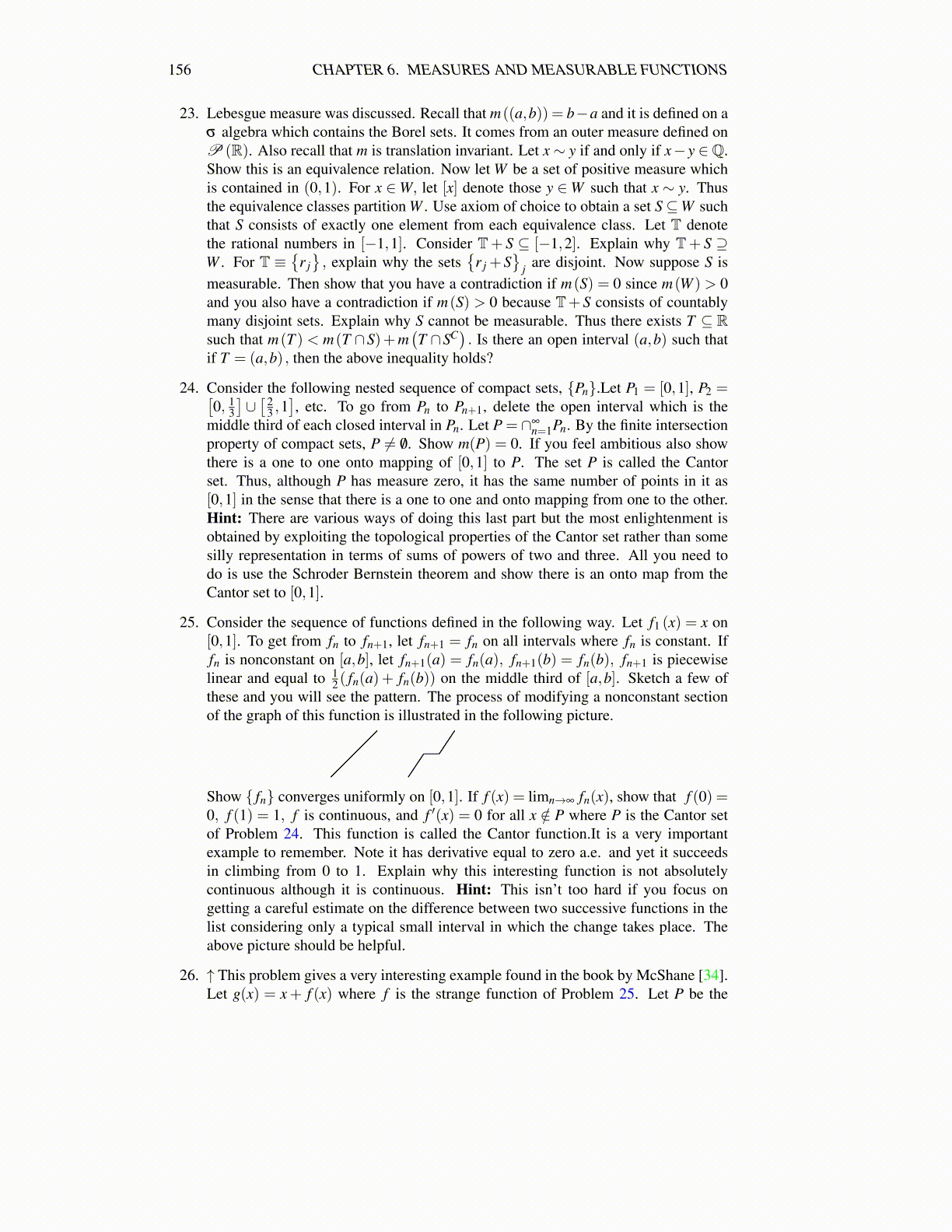
156 CHAPTER 6. MEASURES AND MEASURABLE FUNCTIONS
23. Lebesgue measure was discussed. Recall that m((a,b)) = b−a and it is defined on aσ algebra which contains the Borel sets. It comes from an outer measure defined onP (R). Also recall that m is translation invariant. Let x∼ y if and only if x− y ∈Q.Show this is an equivalence relation. Now let W be a set of positive measure whichis contained in (0,1). For x ∈W, let [x] denote those y ∈W such that x ∼ y. Thusthe equivalence classes partition W . Use axiom of choice to obtain a set S⊆W suchthat S consists of exactly one element from each equivalence class. Let T denotethe rational numbers in [−1,1]. Consider T+ S ⊆ [−1,2]. Explain why T+ S ⊇W . For T ≡
{r j}, explain why the sets
{r j +S
}j are disjoint. Now suppose S is
measurable. Then show that you have a contradiction if m(S) = 0 since m(W ) > 0and you also have a contradiction if m(S) > 0 because T+ S consists of countablymany disjoint sets. Explain why S cannot be measurable. Thus there exists T ⊆ Rsuch that m(T ) < m(T ∩S)+m
(T ∩SC
). Is there an open interval (a,b) such that
if T = (a,b) , then the above inequality holds?
24. Consider the following nested sequence of compact sets, {Pn}.Let P1 = [0,1], P2 =[0, 1
3
]∪[ 2
3 ,1], etc. To go from Pn to Pn+1, delete the open interval which is the
middle third of each closed interval in Pn. Let P = ∩∞n=1Pn. By the finite intersection
property of compact sets, P ̸= /0. Show m(P) = 0. If you feel ambitious also showthere is a one to one onto mapping of [0,1] to P. The set P is called the Cantorset. Thus, although P has measure zero, it has the same number of points in it as[0,1] in the sense that there is a one to one and onto mapping from one to the other.Hint: There are various ways of doing this last part but the most enlightenment isobtained by exploiting the topological properties of the Cantor set rather than somesilly representation in terms of sums of powers of two and three. All you need todo is use the Schroder Bernstein theorem and show there is an onto map from theCantor set to [0,1].
25. Consider the sequence of functions defined in the following way. Let f1 (x) = x on[0,1]. To get from fn to fn+1, let fn+1 = fn on all intervals where fn is constant. Iffn is nonconstant on [a,b], let fn+1(a) = fn(a), fn+1(b) = fn(b), fn+1 is piecewiselinear and equal to 1
2 ( fn(a)+ fn(b)) on the middle third of [a,b]. Sketch a few ofthese and you will see the pattern. The process of modifying a nonconstant sectionof the graph of this function is illustrated in the following picture.
Show { fn} converges uniformly on [0,1]. If f (x) = limn→∞ fn(x), show that f (0) =0, f (1) = 1, f is continuous, and f ′(x) = 0 for all x /∈ P where P is the Cantor setof Problem 24. This function is called the Cantor function.It is a very importantexample to remember. Note it has derivative equal to zero a.e. and yet it succeedsin climbing from 0 to 1. Explain why this interesting function is not absolutelycontinuous although it is continuous. Hint: This isn’t too hard if you focus ongetting a careful estimate on the difference between two successive functions in thelist considering only a typical small interval in which the change takes place. Theabove picture should be helpful.
26. ↑ This problem gives a very interesting example found in the book by McShane [34].Let g(x) = x+ f (x) where f is the strange function of Problem 25. Let P be the